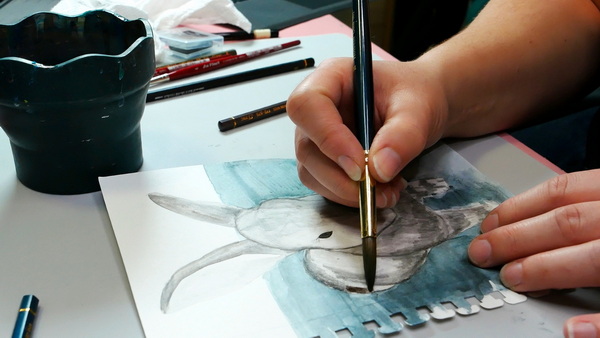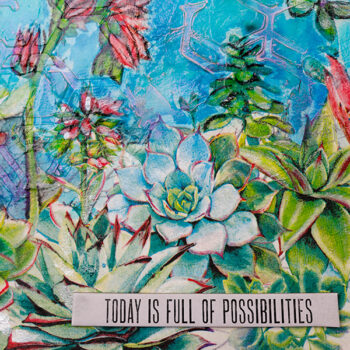
How to use Water Soluble Graphite
Water soluble graphite is a unique and beautiful medium that is perfect for using in an art journal. What makes water soluble graphite pencils interesting is they have both graphite and water-soluble properties in one medium.
If you’ve never used water soluble graphite, today I will introduce you to this medium and how to use it. I’ll also share with you several things to consider when choosing these pencils as part of your art journaling supplies.
Hop-A-Long Studio is reader-supported. When you buy through links on our site, we may earn an affiliate commission at no cost to you. Learn more.
What is Water Soluble Graphite?
Water soluble graphite is a graphite pencil that writes and looks like graphite. But when blended with water using a brush, it can be blended out, shaded and the color of the graphite can be seen. All graphite pencils will bleed slightly if water is applied. But water soluble graphite pencils are formulated to blend with water and create beautiful saturated color on your surface.

My favorite brand of water-soluble graphite pencils is the Caran d’Ache Technalo graphite pencils. I love these pencils because of the quality of the graphite and the beautiful intensity of the blended color. These pencils are available in several colors, not only in black but also in red, blue, and green hues.
What is the Difference between Watercolor Pencils and Water-Soluble Graphite?
Watercolor pencils are a mixture of a water-soluble binder and pigment. When they are applied to the surface, they are the same color that will be blended out with water onto the page. They are vibrant and intense based on the color of the pigment in the pencil.
Water-soluble graphite is made of graphite and writes like any other graphite pencil. As you can see in the sample below, before water is added to them, there are no distinguishing colors between each of the pencils.

When water is added to the water-soluble graphite, the color of the graphite can be seen. Water-soluble graphite comes in only a few colors and the tone is muted as it is a graphite based color, not a pigment based color.
Best Paper for Water-Soluble Graphite
My favorite surfaces for water-soluble graphite are Bristol paper and watercolor paper.

When using watercolor paper, the graphite will draw less smoothly as it will pick up the texture of the watercolor paper. But when the graphite is blended out with a wet brush, you will get a very even blend as the watercolor paper is meant to take a lot of water and color.
When using Bristol paper, the graphite will draw very smoothly and will have almost no texture. But when water is added, it will pool onto the surface more than the watercolor paper. You may also notice that the paper may buckle a bit over time as more water is added.
Both will work very well with the water-soluble graphite. You may choose one over the other depending on how much blending and water you plan to add. If you plan to blend mostly with a wet brush, I suggest watercolor paper. If you plan to draw mostly with graphite and only use wet brush blending for a few highlights, use Bristol paper.
Blending Water Soluble Graphite
To blend water soluble graphite, add graphite to the surface. Using a wet brush, blend out the water-soluble graphite to see the color appear. Depending on how much water and graphite you use, this affects the blend that you get with the graphite.
Blending Tips for Graphite

When using water-soluble graphite on your project, add a little bit of graphite at a time and blend out with a wet brush. If you add a heavy layer of graphite to your entire image, it will end up very dark.
This blending technique takes time and practice to figure out how much graphite to add and how much water to use with a brush.
I like to add graphite to the shadow areas of my project and use a brush to pull the color out creating lighter shades. You can always add more graphite, but this way it will prevent you from going too dark too quickly on your project.
Wet on Wet Techniques

If you want to add color and your surface is still wet, you can add graphite directly to the piece. I only use this technique very rarely on my projects. The marks will be very strong and will not blend out after being applied. I tend to only do this in places that I want to define specific details and shapes.
My favorite wet on wet technique with water-soluble graphite is to take a wet brush and grab color straight from the tip of the graphite pencil. This will be very intense color, but it will blend beautifully on a wet surface.
Removing Color

If you surface is still wet and you want to remove some of the colored graphite, you can dab color off with a paper towel. There will still be some graphite on the surface, but the shade will be much lighter.
Another option is to take your wet brush, dab it off on a paper towel to remove water from the brush, and pick up color from the wet surface. This is a more subtle way to pick up the color and lighten your surface.
Working in Layers

I tend to work in layers with my water-soluble graphite. By working in layers, you can build up intensity, values, and dimension in your creative projects. After creating your first layer of graphite, let it dry completely.
Once dry, you can add in more graphite to the surface and use your brush to blend the color into the first layer.
Adding Details

For adding final details, I like using a fine watercolor brush (usually size 0) with the water-soluble graphite pencils. For this page, I added in another layer of black to the eye, added lashes and whiskers to the rabbit. Using a fine watercolor brush, I wet the graphite to give it a more intense color.
When drawing animals, I tend to add a small catchlight in the eye using a Posca white acrylic marker. This gives the subject more life and makes the picture more dynamic.
I love adding highlights with a white charcoal pencil to finish off the page. For this piece I added in texture to the ears, highlights around the eyes, and fluffiness to the feet. The charcoal pencil will blend with the graphite but will provide nice highlights to the page.
Working Through Grief in the Art Journal
With this art journal page, my focus was working through the grief process. The subject of this page was Flopsy, my pet rabbit who passed away very recently. Grief can be so challenging, and the art journal is a very cathartic way to work through grief.
The art journal can help us process our feelings, remember the good and work through our grief. It may not be one art journal page, but a dozen to work through those feelings. But it is a great place for personal expression, to share memories, and to own your grief and sadness.
Flopsy was 8 years and 11 months old when she passed away. It wasn’t an easy decision to say goodbye, and this came with strong feelings of loss. Going through the stages of grief isn’t easy. Working through feelings of denial, anger, bargaining, depression, and acceptance takes time. For me, it also came with questions of “Should I have done more? Did I love her enough in her life?”
These feelings are normal, but it takes time to work through the emotions. What I love about the art journal is that it is a place where you can revisit feelings, and if it takes dozens of pages to work through the grief, that’s ok. It’s a place for us to take the time to process, to deal with loss and move on from it. If you are dealing with a loss in your life, there are some fantastic resources available to help you through your grief and loss.
Water Soluble Graphite Art Journal Pages
As I’ve been working through my grief, here are a few more examples of using water soluble graphite in my art journal.

In this piece, I used the Phthalocyanine Green, Carmine Lake and Black Technalo pencils. I also used white charcoal pencil and paint pens for the final highlights and journaling.

For this piece, I used Carmine Lake for coloring Flopsy, Prussian Blue for Priscilla, and used the black pencil for the ground and shadows. For both rabbits, I used black highlights to accentuate features in their faces.
Questions?

Any questions about this medium or how to use them? I’d love to see your comments below and start a conversation with you about your experience with water-soluble graphite.
As you can see, with only 4 water soluble graphite pencils, there is a variety of ways to use these pencils in your work. The limited color palette can help us simplify our pages and learn more about creating values in our projects. I would love to hear what you think of this medium and if you’ve used water-soluble graphite in your projects before!
Project Supply List
Strathmore 200 Watercolor Paper
Strathmore 300 Series Bristol Paper
Caran d’Ache Technalo Water Soluble Pencil Carmine Lake, Prussian Blue Technalo, Phthalocyanine Green and 3B Black
Derwent White Charcoal Pencil
daVinci Cosmotop Spin Watercolor Brushes
Posca White Paint Pen





